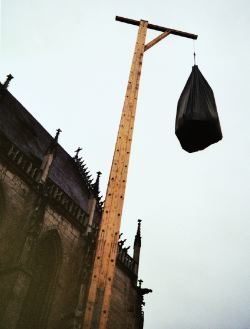The Last Post
A long time ago in a town far, far away, to the dismay of the public a sculpture was erected
A long time ago in a town far, far away, to the dismay of the public a sculpture was erected

The artist was famous, but it is doubtful anyone in the town knew that, and whether or not this information would have changed the subsequent course of events. What was clear, by the lack of community uproar, was that destroying a piece of art is not that big a deal. The vandals took their time. Slowly, throughout the summer and into the autumn, perhaps with axes or other hacking tools, they chopped away at it. As though the sculpture were living within an Anselm Kiefer painting, it took on the tone of an Expressionist icon. Perhaps this was intentional on the part of the crowd, trying to tame its odd sensuality by relegating it to a Medieval forest fantasy. Somehow they managed to take its top off. Because it was big, it was an easy target but also quite a challenge. Finally, resorting to an old standby, they burnt it down. I thought quite a bit about Richard Serra's Tilted Arc (1981) in the financial district of New York, and about what happens when art is put in people's way rather than in their public museums. Being forced to look at art seems to make some people angry. This is not true in the case of Jeff Koons' Puppy (1992), a piece that was destined and designed to be loved. I once met a man at a dog show who learned his West Highland Terrier had died on the same day he saw Puppy (quite by accident) in the Rockefeller Center. He believed it was a message from God.
Unlike Koons floral hit parade, Jannis Kounellis' Untitled (Platzverfuhrung) (1992) was never going to win the hearts of Catholic southern Germany. Nor, I gather, was it intended to. An enormous lynching post positioned next to the country's largest one-room church (and the town's single tourist draw) must have come as a shock to church-goers and tour group organizers alike. A towering, Gulliveresque structure, it had at its tip a giant sack filled with what I later learned was middle-class furniture. I can only guess what this was supposed to represent death to the middle classes? and I'm not sure the people who attacked the piece ever really thought about it. For them, I suppose, the work was an intruder, casting a shadow over their religion and suggesting in some way that their church was the site of extreme condemnation. More ironic than the fact that middle-class furniture is so collectable, is that this town is also the central location in a folkloric tale involving a violinist who comes to Schwäbisch Gmünd with no money to pay for food or lodging. He prays to a statue of St Cecilia, who comes to life and hands him a valuable bauble. Later, he is accused of stealing from the church and is hanged in the market-place.
That same summer someone stole a weather vane off the roof of the other famous one-room church in town. This student-style prank received more attention than the burnt sculpture, partly because, unbeknown to the thieves, the weather vane was made of solid gold. At some point it found its way back to the church, maybe at the same time the stump that was once Kounnellis' piece was removed.

















